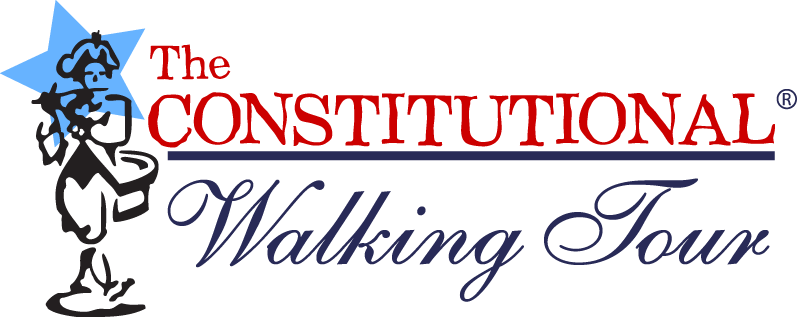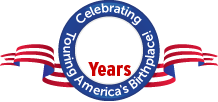Related Posts
- Buy Tickets for The Constitutional Walking Tour of Philadelphia – See 20+ Sites on a Primary Overview of Independence Park, including the Liberty Bell and Independence Hall
- Bill of Rights
- Carpenters' Hall
- The Liberty Bell
Overview
According to the "Historical Dictionary of Organized Labor" by James C. Docherty, one of the first organized labor movements in the United States was in the 1780s with the formation of trade societies by journeymen in Philadelphia. The journeymen's purpose was to meet annually with masters to settle the price of their labor. Additionally, in 1786 (one year before the Constitution of the United States was created and ratified), the first strike of employees in a single trade occurred with Philadelphia printers.
On The Constitutional Walking Tour of Philadelphia, we celebrate The Declaration of Independence, the Constitution of the United States and the Bill of Rights. The principles enshrined in The Declaration of Independence of "all men are created equal" and "life, liberty and the pursuit of happiness", along with those rights in the Constitution with freedom of speech, freedom of the press, the right to peacefully assemble and the right to petition the government for a redress of grievances, helped shape the foundation on which the Labor Movement in the United States has been built.
The Labor Monument in Philly
The union worker built America -- its skyscrapers, its roads, its freeways, its interstates, its factories, etc. The Labor Monument: Philadelphia’s Tribute to the American Worker is a beautiful and thought provoking tribute to American Labor by artist John Kindness (whose father was a shipyard worker) that is located in Elmwood Park in the Southwest part of Philadelphia.
Cathy Brady was the driving force behind The Labor Monument who helped the Friends of Elmwood Park work with the City of Philadelphia’s Association for Public Art (formerly known as the Fairmount Park Art Association).
The Labor Monument commemorates the contributions of organized labor nationwide and Philly’s working class history. Celebrating Philadelphia’s pivotal and unique role in the American labor movement, the artwork serves as a community gathering space and as an “outdoor history lesson."
The Labor Monument is composed of seven bronze relief Work Table Buttons that represent important events in labor history. The buttons were inspired by old work buttons on the blue jeans of blue collar workers:
1) Eugene Victor Debs: Labor and a Political Campaign
In 1893, Eugene V. Debs (November 5, 1855 – October 20, 1926) organized the American Railway Union (ARU) which was the first industrial union in the United States. Debs was an activist for social justice, and he was astute in understanding labor's voice of the working class to be heard among political leaders. During his lifetime, Debs was an outspoken progressive for various social ideas including the right of workers to form and join unions, worker safety, restriction of child labor, and women's suffrage. Debs gave up everything for what he believed in and he ran for President of the United States five times. On June 16, 1918, Debs made a speech in Canton, Ohio urging resistance to the military draft of World War I. He was arrested on June 30 and charged with ten counts of sedition. Even after he was sentenced to 10 years in prison, Debs ran for President in the 1920 election, and he received almost 1 million votes with 3.4% of the total vote. This number of votes was slightly less than he had received in 1912 when he received about 6% of the total vote.
2) Big Bill Haywood: Advocated for Child Labor Reform and Against Stealing the Playtime of Children
William Dudley "Big Bill" Haywood (February 4, 1869 – May 18, 1928) is best remembered by his statement, "The worst thief is he who steals the playtime of children." In 1903, labor leader Mother Jones led a march of children workers from Philadelphia to Theodore Roosevelt's summer home on Long Island, New York, to protest the exploitation of underage workers. This was so important because the children who were made to work were being robbed of their childhood. To that end, they did not get to go to school, they did not get time to play with their friends and often times were exposed to dangerous working conditions in coal mines and textile mills. In 1938, the Fair Labor Standards Act was enacted, which ended child labor in factories and mines in the U.S., although child labor is still a concern, especially in developing countries.
3) The Wobblies: "Don't waste time mourning, organize!"
In 1905, the Continental Congress of the Working Class convened to establish an organization that would represent all working people, regardless of their trade. The result was the birth of the Industrial Workers of the World, also known as I.W.W. or "The Wobblies." The I.W.W. used music to spread their ideas. Joe Hill (October 7, 1879 – November 19, 1915), folk hero and labor martyr, became a symbol of the quest for economic and social justice for all workers. Hill's slogan, "Don't waste time mourning, organize!" is still a labor rallying cry today.
4) Bread & Roses: Labor & The Women's Rights Movement
In 1912, thousands of brave textile mill workers in shirtwaist factories in Lawrence, Massachusetts, went on strike after the mills' owners made substantial pay cuts, but insisted that they work the same amount of hours (which was longer than 8 hours since there was not an 8 hour workday at that time). The workers, most of whom were women, linked arms in solidarity and formed a human chain around the mills. The also created the moving picket line so that they would not be arrested for loitering. Their slogan, "We want bread and roses, too," symbolized their fight for economic security and a better quality of life. In other words, they fought for the right to be able to afford to put bread on the table, but also to go home and enjoy life a little after work. The campaign brought attention to the significance of the role of women in the work place and made labor another area in the struggle for women's equal rights.
5) "¡Si, Se Puede!": Farm Workers Organize
In 1966, the United Farm Workers (UFW) formed under the leadership of one of labor's greatest contemporary leaders Cesar E. Chavez (March 31, 1927 – April 23, 1993). With the rallying cry of "¡Si, Se Puede!" (Yes, We Can!), the UFW organized thousands of immigrant farm workers to raise awareness of their deplorable working conditions in the hot blazing sun. These "piecemeal workers" were physically strained since the work was back breaking -- they were constantly bent over picking crops and if they did not pick enough baskets, they did not get paid. The symbol of the UFW is a stylized eagle with wings at right angles, so it could be easily drawn and reproduced by farm workers. Given that a lot of workers were illiterate and that it was dangerous for them to communicate verbally about organizing, the UFW members had an elegant way of announcing their presence in a district and calling farm workers to a meeting. They would draw the geometric UFW eagle symbol in the sand as a means to organize.
6) "I AM A Man": Labor Joins the Civil Rights Movement
In February 1968, following the tragic deaths of two sanitation workers in Memphis, Tennessee, 1,300 African American sanitation workers in Memphis went on strike and carried signs that read, "I AM A MAN." The plea of the striking sanitation workers was for economic justice and moreover against racism. These workers were members of the American Federation of State, County and Municipal Employees (AFSCME) union, and their plight resonated with AFSCME workers and African Americans throughout the United States who were seeking meaningful equality. Their strike caught the attention of Dr. Martin Luther King, Jr., who went to Memphis in support of these AFSCME workers. On April 3, 1968, Dr. King delivered his "I've Been to the Mountaintop" address to the striking workers. Dr. King spoke to the First Amendment privileges with freedom of assembly, freedom of speech, the freedom of the press, the right to protest, etc. Unfortunately, this was Dr. King's last speech since he was assassinated the next day in Memphis on April 4, 1968.
7) Karen Silkwood – Worker and Occupational Safety
Karen Gay Silkwood (February 19, 1946 - November 13, 1974) was an employee at a nuclear fuel processing plant in Oklahoma when she discovered evidence of unexplained leaks and spills that posed threats to the workers' health. She was a single mom and union activist who took on the nuclear industry. In 1974, Silkwood was killed in a suspicious car accident on her way to discuss her findings with a reporter from The New York Times and an official from the U.S. Atomic Energy Commission. Silkwood's courageous life and untimely death served as a catalyst to reform safety in the workplace and provide protection for whistleblowers. Silkwood is credited with inspiring workers across the U.S. with the courage to report violations of health and safety regulations.
In 1983, Silkwood's story was brought to the Big Screen in "Silkwood" which was nominated for a 1983 Academy Award. In the movie, Silkwood was portrayed by Meryl Streep, and the movie also starred Kurt Russell and Cher.
Insider Information
If you want to learn more about how The Constitutional Walking Tour celebrates The Declaration of Independence, the Constitution of the United States and the Bill of Rights, click here. As Dr. King noted in his famous "I've Been to the Mountaintop", the principles enshrined in the Constitution with freedom of speech, freedom of the press, the right to peacefully assemble and the right to petition the government for a redress of grievances, helped shape the foundation on which the Labor Movement in the United States has been built.
In addition to the information above, if you would like to read more about The Labor Monument, click here.
Additional Information
Philadelphia Labor Monument
Elmwood Park
71st Street and Buist Avenue
Philadelphia, PA 19153



